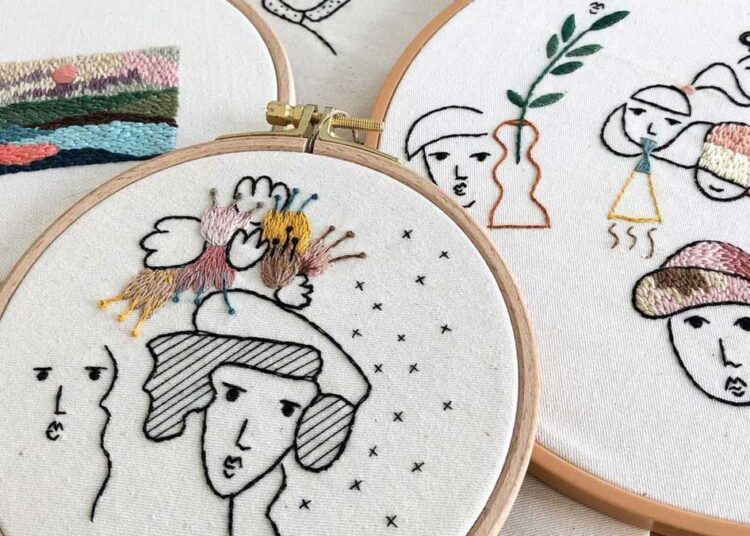Embroidery, an ancient art form that has captivated the hearts and minds of people for centuries, is experiencing a remarkable resurgence in the contemporary art world. Once relegated to the realm of traditional crafts, embroidery is now being embraced by a new generation of artists who are pushing the boundaries of this time-honored technique.
The History of Embroidery
Embroidery has a rich and diverse history that spans across cultures and continents. From the intricate tapestries of ancient China to the vibrant needlework of the Middle East, this art form has been used to tell stories, express cultural identity, and showcase the incredible skill and creativity of its practitioners. Over the centuries, embroidery has evolved, incorporating new materials, techniques, and design elements that have kept it relevant and captivating.
The Different Types of Embroidery Techniques
Embroidery encompasses a wide range of techniques, each with its own unique characteristics and applications. Some of the most common types of embroidery include:
- Cross-Stitch: A classic technique that involves creating a series of X-shaped stitches to form intricate patterns and designs.
- Needlepoint: A form of embroidery where the stitches are worked on a stiff fabric, often creating a textured, three-dimensional effect.
- Crewel Embroidery: A technique that utilizes wool thread to create elaborate, flowing designs on a linen or cotton foundation.
- Freestyle Embroidery: A more open-ended approach that allows artists to explore a variety of stitches and materials to create their own unique expressions.
The Role of Embroidery in Contemporary Art
In recent years, embroidery has undergone a remarkable transformation, emerging as a powerful medium for contemporary artists to explore a wide range of themes and ideas. These artists are using embroidery to challenge traditional notions of craft, to comment on social and political issues, and to create visually stunning works that captivate and inspire.
Famous Contemporary Embroidery Artists
Some of the most renowned contemporary embroidery artists include:
- Cayce Zavaglia: An American artist who creates hyperrealistic portraits using intricate thread work, blending traditional embroidery techniques with a modern, fine art sensibility.
- Joana Vasconcelos: A Portuguese artist who incorporates embroidery into large-scale, conceptual installations that explore themes of gender, identity, and societal norms.
- Eliza Bennett: A British artist who uses embroidery to create thought-provoking works that address issues of feminism, social justice, and the human condition.
- Maurizio Anzeri: An Italian artist who transforms found photographs into ethereal, embroidered works that blur the line between photography and textile art.
How to Get Started with Embroidery
If you’re interested in exploring the art of embroidery, the first step is to gather the essential supplies. This includes:
- Embroidery Floss: A variety of colors and textures to suit your creative needs.
- Embroidery Needles: Specialized needles with large eyes and sharp points for easy threading and stitching.
- Embroidery Hoop: A circular frame that holds the fabric taut while you work.
- Fabric: A range of materials, from cotton to linen, that can be used as a canvas for your embroidery.
- Scissors: Sharp, high-quality scissors for cutting threads and fabric.
Once you have your supplies, you can begin experimenting with different stitches and techniques, drawing inspiration from the rich history of embroidery and the innovative work of contemporary artists.
Embroidery Tips and Tricks
As you start your embroidery journey, here are some tips and tricks to help you along the way:
- Experiment with Different Threads: Explore a variety of thread types, including cotton, silk, and metallic, to add depth and texture to your work.
- Embrace Imperfections: Embroidery is a handmade art form, so embrace the natural variations and slight imperfections that give your work character.
- Use a Hoop for Stability: Keeping your fabric taut in an embroidery hoop will help you maintain consistent tension and create cleaner stitches.
- Take Your Time: Embroidery is a meditative process, so enjoy the journey and don’t rush your work.
- Explore Unconventional Surfaces: Consider using unexpected materials, such as leather, denim, or even paper, as your canvas for embroidery.
Embroidery as a Form of Self-Expression
Beyond its technical and aesthetic merits, embroidery can also serve as a powerful tool for self-expression and personal exploration. By stitching their stories, emotions, and experiences into their work, contemporary embroidery artists are using this ancient art form to connect with themselves and their audiences in profound and meaningful ways.
Embroidery in Fashion and Home Decor
Embroidery has long been a staple in the world of fashion and home decor, with designers and interior decorators incorporating intricate needlework into their creations. From couture gowns adorned with delicate floral motifs to throw pillows and wall hangings that showcase the beauty of this craft, embroidery continues to be a beloved and versatile medium for adding texture, color, and visual interest to a wide range of products.
Conclusion
As the art of embroidery continues to evolve and captivate audiences around the world, it is clear that this timeless craft has a vital role to play in the contemporary art landscape. Whether you are a seasoned embroidery artist or just beginning to explore this medium, the possibilities for creative expression are endless. So, pick up a needle, thread, and let your imagination soar as you embark on your own embroidery journey.
Discover the transformative power of embroidery and unlock your creative potential. Join our community of passionate artists and explore the endless possibilities of this timeless craft. Visit our website to learn more about our upcoming workshops, tutorials, and exclusive resources designed to help you master the art of embroidery.



